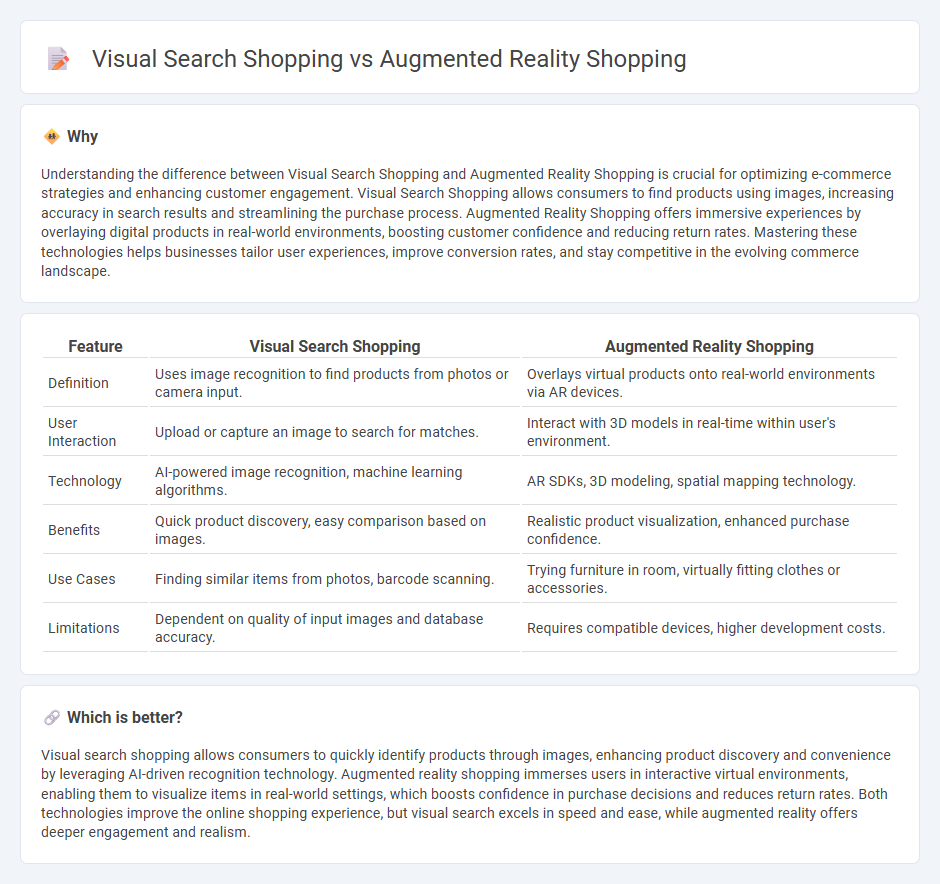
Visual search shopping allows consumers to find products simply by uploading images, streamlining the discovery process through AI-driven recognition technology. Augmented reality shopping enhances user experience by overlaying virtual products into real-world environments, enabling interactive and immersive product visualization. Explore the transformative impact of these innovations on modern commerce and consumer behavior.
Why it is important
Understanding the difference between Visual Search Shopping and Augmented Reality Shopping is crucial for optimizing e-commerce strategies and enhancing customer engagement. Visual Search Shopping allows consumers to find products using images, increasing accuracy in search results and streamlining the purchase process. Augmented Reality Shopping offers immersive experiences by overlaying digital products in real-world environments, boosting customer confidence and reducing return rates. Mastering these technologies helps businesses tailor user experiences, improve conversion rates, and stay competitive in the evolving commerce landscape.
Comparison Table
| Feature | Visual Search Shopping | Augmented Reality Shopping |
|---|---|---|
| Definition | Uses image recognition to find products from photos or camera input. | Overlays virtual products onto real-world environments via AR devices. |
| User Interaction | Upload or capture an image to search for matches. | Interact with 3D models in real-time within user's environment. |
| Technology | AI-powered image recognition, machine learning algorithms. | AR SDKs, 3D modeling, spatial mapping technology. |
| Benefits | Quick product discovery, easy comparison based on images. | Realistic product visualization, enhanced purchase confidence. |
| Use Cases | Finding similar items from photos, barcode scanning. | Trying furniture in room, virtually fitting clothes or accessories. |
| Limitations | Dependent on quality of input images and database accuracy. | Requires compatible devices, higher development costs. |
Which is better?
Visual search shopping allows consumers to quickly identify products through images, enhancing product discovery and convenience by leveraging AI-driven recognition technology. Augmented reality shopping immerses users in interactive virtual environments, enabling them to visualize items in real-world settings, which boosts confidence in purchase decisions and reduces return rates. Both technologies improve the online shopping experience, but visual search excels in speed and ease, while augmented reality offers deeper engagement and realism.
Connection
Visual search shopping and augmented reality shopping enhance e-commerce by enabling customers to find and visualize products effortlessly. Visual search uses image recognition algorithms to identify items from photos, while augmented reality overlays virtual products into real-world environments, providing interactive experiences. Together, they increase customer engagement and improve purchase confidence through seamless product discovery and realistic previews.
Key Terms
User Experience (UX)
Augmented reality shopping enhances user experience by allowing customers to visualize products in their real environment through interactive 3D models, reducing purchase uncertainty and increasing engagement. Visual search shopping improves UX by enabling users to find products quickly using images rather than text queries, streamlining the discovery process and enhancing convenience. Explore how these technologies transform retail interactions and elevate customer satisfaction.
Product Visualization
Augmented reality shopping enhances product visualization by overlaying 3D models onto real-world environments, allowing customers to interact with items in a lifelike setting before purchase. Visual search shopping uses image recognition technology to identify products from photos, quickly connecting users to exact or similar items online. Explore the latest advancements in product visualization for a seamless shopping experience.
Search Technology
Augmented reality shopping uses advanced 3D modeling and spatial recognition technology to overlay virtual products in real-world environments, enhancing customer interaction and decision-making through immersive experiences. Visual search shopping leverages image recognition algorithms and deep learning to identify products from photos or videos, enabling users to find items quickly by uploading or capturing images. Explore more about how these cutting-edge search technologies reshape e-commerce innovation.
Source and External Links
Augmented reality retail: How AR is transforming the shopping ... - Augmented reality in retail enhances shopping by overlaying digital information on the real world, enabling virtual try-ons and home furnishing visualization for more informed buying decisions.
AR Shopping: Top Trends and Apps for the Future (2024) - Shopify - AR shopping lets customers virtually try and test products via smartphones or VR devices, creating immersive shopping experiences and driving substantial market growth.
Top 5 Augmented Reality Apps that Created Immersive Shopping ... - AR apps provide a try-before-you-buy experience by allowing customers to visualize products in their real environment, enhancing confidence and reducing returns.
 dowidth.com
dowidth.com